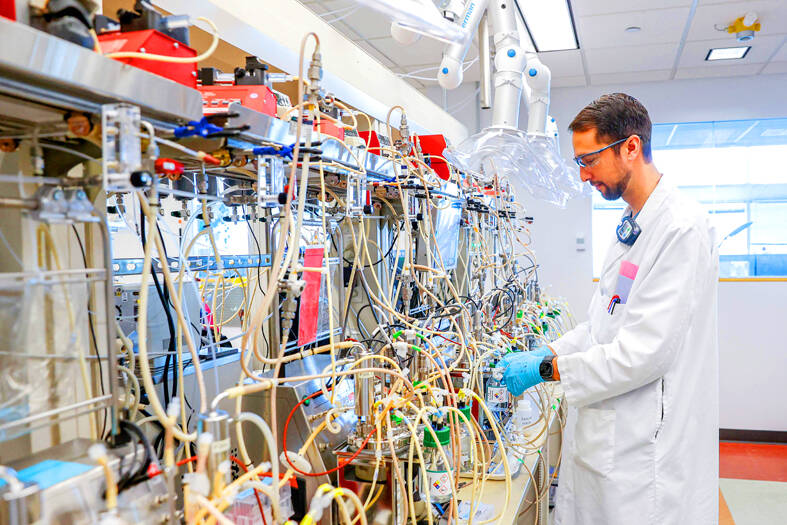At LanzaTech’s lab in the Chicago suburbs, a beige liquid bubbles away in dozens of glass vats. The concoction includes billions of hungry bacteria, specialized to feed on polluted air — the first step in a recycling system that converts greenhouse gases into usable products.
Due to licensing agreements, LanzaTech’s novel microorganisms are already being put to commercial use by three Chinese factories, converting waste emissions into ethanol.
That ethanol is then used as a chemical building block for consumer items such as plastic bottles, athletic wear and even dresses, via tie-ins with major brands such as Zara and L’Oreal.

Photo: AFP
“I wouldn’t have thought that 14 years later, we would have a cocktail dress on the market that’s made out of steel emissions,” said microbiologist Michael Kopke, who joined LanzaTech a year after its founding.
To date, LanzaTech has kept 200,000 tonnes of carbon dioxide out of the atmosphere, while producing 190 million liters of ethanol, the company said.
That is a small drop in the bucket when it comes to the actual quantities needed to combat climate change, Kopke said.
However, having spent 15 years developing the methodology and proving its large-scale feasibility, the company is now seeking to ramp up its ambitions and multiply the number of participating factories.
“We really want to get to a point where we only use above-ground carbon, and keep that in circulation,” Kopke said — in other words, avoid extracting new oil and gas.
LanzaTech, which employs about 200 people, compares its carbon recycling technology to a brewery — but instead of taking sugar and yeast to make beer, it uses carbon pollution and bacteria to make ethanol.
The bacterium used in its process was identified decades ago in rabbit droppings.
The company placed it in industrial conditions to optimize it in those settings, “almost like an athlete that we trained,” Kopke said.
Bacteria are sent out in the form of a freeze-dried powder to corporate clients in China, which have giant versions of the vats back in Chicago, several meters high.
The corporate clients that built these facilities then reap the rewards of the sale of ethanol — as well as the positive PR from offsetting pollution from their main businesses.
The clients in China are a steel plant and two ferroalloy plants. Six other sites are under construction, including one in Belgium for an ArcelorMittal SA plant, and in India with IndianOil Corp.
Because the bacteria can ingest carbon monoxide, carbon dioxide and hydrogen, the process is extremely flexible, LanzaTech vice president of science Zara Summers said.
“We can take garbage, we can take biomass, we can take off gas from an industrial plant,” said Summers, who spent 10 years working for ExxonMobil Corp.
Products already on the shelves include a line of dresses at Zara. Sold at about US$90, they are made of polyester, 20 percent of which comes from captured gas.
“In the future, I think the vision is there is no such thing as waste, because carbon can be reused again,” Summers said.
LanzaTech has also founded a separate company, LanzaJet, to use the ethanol to create sustainable aviation fuel (SAF).
Increasing global SAF production is a huge challenge for the fuel-heavy aviation sector, which is seeking to green itself.
LanzaJet is aiming to achieve 1 billion gallons of SAF production in the US per year by 2030.
Unlike bioethanol produced from wheat, beets or corn, fuel created from greenhouse gas emissions does not require the use of agricultural land.
For LanzaTech, the next challenge is to commercialize bacteria that would produce chemicals other than ethanol.
In particular, they have their sights set on directly producing ethylene, “one of the most widely used chemicals in the world,” Kopke said — thus saving energy associated with having to first convert ethanol into ethylene.

Leading Taiwanese bicycle brands Giant Manufacturing Co (巨大機械) and Merida Industry Co (美利達工業) on Sunday said that they have adopted measures to mitigate the impact of the tariff policies of US President Donald Trump’s administration. The US announced at the beginning of this month that it would impose a 20 percent tariff on imported goods made in Taiwan, effective on Thursday last week. The tariff would be added to other pre-existing most-favored-nation duties and industry-specific trade remedy levy, which would bring the overall tariff on Taiwan-made bicycles to between 25.5 percent and 31 percent. However, Giant did not seem too perturbed by the

AI SERVER DEMAND: ‘Overall industry demand continues to outpace supply and we are expanding capacity to meet it,’ the company’s chief executive officer said Hon Hai Precision Industry Co (鴻海精密) yesterday reported that net profit last quarter rose 27 percent from the same quarter last year on the back of demand for cloud services and high-performance computing products. Net profit surged to NT$44.36 billion (US$1.48 billion) from NT$35.04 billion a year earlier. On a quarterly basis, net profit grew 5 percent from NT$42.1 billion. Earnings per share expanded to NT$3.19 from NT$2.53 a year earlier and NT$3.03 in the first quarter. However, a sharp appreciation of the New Taiwan dollar since early May has weighed on the company’s performance, Hon Hai chief financial officer David Huang (黃德才)

NVIDIA FACTOR: Shipments of AI servers powered by GB300 chips would undergo pilot runs this quarter, with small shipments possibly starting next quarter, it said Quanta Computer Inc (廣達), which supplies artificial intelligence (AI) servers powered by Nvidia Corp chips, yesterday said that AI servers are on track to account for 70 percent of its total server revenue this year, thanks to improved yield rates and a better learning curve for Nvidia’s GB300 chip-based servers. AI servers accounted for more than 60 percent of its total server revenue in the first half of this year, Quanta chief financial officer Elton Yang (楊俊烈) told an online conference. The company’s latest production learning curve of the AI servers powered by Nvidia’s GB200 chips has improved after overcoming key component

UNPRECEDENTED DEAL: The arrangement which also includes AMD risks invalidating the national security rationale for US export controls, an expert said Nvidia Corp and Advanced Micro Devices Inc (AMD) have agreed to pay 15 percent of their revenue from Chinese artificial intelligence (AI) chip sales to the US government in a deal to secure export licenses, an unusual arrangement that might unnerve both US companies and Beijing. Nvidia plans to share 15 percent of the revenue from sales of its H20 AI accelerator in China, a person familiar with the matter said. AMD is to deliver the same share from MI308 revenue, the person added, asking for anonymity to discuss internal deliberations. The arrangement reflects US President Donald Trump’s consistent effort to engineer